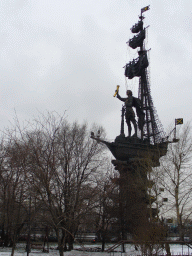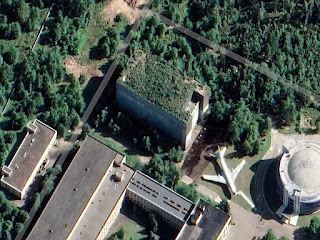Twenty-five years ago, on April 12, Yuri Gagarin became the first person to venture into space. His successful launch stunned the Americans, resulting in Kennedy's decision to race for the moon. Today, Garry and I toured Zvezdny Gorodok, better known as Star City. It was here that Yuri and those who followed him first trained as cosmonauts.
Our tour centred around Gagarin Cosmonauts Training Centre (GCTC), a compact compound located within a highly restricted military facility northeast of Moscow. Russian cosmonauts continue to live and train here. The site consisted of two parts, the training facility itself, and a small residential area for the military and civilian personnel serving the centre, as well as the cosmonauts and their families.
Much like the Johnson Space Centre in Texas, the facilities are dated, having a distinct 60s look and feel. However, one can immediately see that Russian space milestones were achieved on a far smaller budget. While Johnson Space Centre sprawls for miles, GCTC's handful of buildings can be seen from a single vantage point, covering the land area of a large Walmart store and its parking lot.
Access to Star City involves passing through no less than three military checkpoints, along roads cut through dense, snow-clad forest. The scene could have been taken directly from a Cold War spy film. The first entrance is marked by a full-sized Soviet jet fighter erected on a large concrete pillar.
As Garry and I walked through the final gate into the main boulevard of GCTC, it was hard to believe where we were. Forty years ago this centre didn't officially exist. It never appeared on Soviet maps and unauthorised access would have guaranteed a lengthy Gulag vacation in Siberia.
Nine of us toured the centre, taking a leisurely four hours to explore three key buildings:
- the MIR training centre which contains a working replica of the space station itself
- the neutral buoyancy Hydro Lab where cosmonauts practice spacewalks in a giant swimming pool
- the TsF-18 Centrifuge room which contains a 300-tonne rotating structure able to simulate the G-forces of spaceflight.
Our tour began with a visit to a full-scale mock-up of MIR once used to train cosmonauts and troubleshoot station problems. Each station module sits in a massive cradle filling a long, sunlight-flooded hall. To one side sits the descent module from the first successful manned Soyuz spaceflight. (The first ended in tragedy when Vladimir Komarov was killed on re-entry after his capsule’s parachute failed).
Our tour guide invited us inside the mock-up, fitted identically to its orbiting counterpart. I was stunned. At Johnson Space Centre, you’re invited to tour the Skylab mock-up but are unable to touch anything inside. At Star City, we were invited to sit at the control panel and flick switches, examine the space toilet and open hidden drawers within the central dining table. We spent at least 45 minutes exploring every corner of MIR.
The private quarters for each cosmonaut were quite an eye-opener. On each side of the main living quarters are small phone booth-size cubicles. Each has a small window and can be screened off with a small curtain. You can see Garry trying out the cubicle below. It's hard to imagine having this as your only private space for months on end.
From the MIR building, we made our way through the snow to the circular HydroLab, located at the far end of the GCTC complex. Inside this building resides a 23-metre diameter tank, 12 metres deep. When filled with water, cosmonauts use neutral buoyancy techniques to practice repairing International Space Station (ISS) facilities. Objects configured to be neutrally buoyant seem to "hover" underwater, thus simulating the effects of weightlessness.
During our visit mock-ups of a Soyuz capsule and the Russian Zarya module were suspended above the water tank on a giant lifting platform. When in use, the entire platform is slowly lowered into the water below. Outside the HydroLab a series of alternative (and disused) modules sat forlornly in the snow.
Perhaps the most fascinating building was one we never visited. Next to the HydroLab sits a derelict seven-story brick building, the façade was crumbling and windows were broken. We never did find out what purpose it had served. One can only surmise that it once housed a now-defunct Soviet space program like Buran or MIR-2.
Our final destination was the Centrifuge building, a building at the opposite end of the GCTC complex. Inside an enormous circular hall sits an equally enormous blue centrifuge - the world's largest such structure. Test subjects sit in a cabin on the end of an 18-metre arm and are rotated at speeds that generate forces of up to 30Gs. The main hall is awe-inspiring, while the centrifuge itself looks like something from an 80s Science Fiction television drama.
Our tour ended with lunch in an empty cafe, sitting in the midst of a nearby apartment complex. The venue was dated and run-down, reflecting the funding challenges that continue to plague the Russian space program. As we drove away, I felt a moment of sorrow. It was sad to witness the former glory of the Soviet space program quietly disintegrating in a bleak, isolated forest.
Click
here for more adventures in Moscow.
UPDATE: 16 June 2023I've finally uncovered the origins of that derelict seven-story building. It was planned as a cosmonaut
training centre for the Soviet's
Buran Space Shuttle. I learned that it was designed to accommodate a vertically stacked Buran in a central gallery, thus simulating its orientation on the launch pad. As a result, the structure towers over surrounding buildings.
Following the dissolution of the Soviet Union, the incredibly expensive Buran program was abandoned. A cash-strapped Russian nation subsequently stopped construction of the unwanted building. For more than thirty years, it has sat there slowly decaying. Satellite images currently show a very healthy crop of vegetation flourishing on its roof.



























